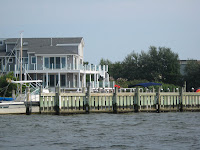 Well, they certainly do look weird - I can't really blame you for asking.
Well, they certainly do look weird - I can't really blame you for asking.Believe it or not, they are actually being used for our terrapin research! This past summer I lined two historic nesting beaches in Barnegat with these orange construction barriers (a very kind donation from Yodock Inc.), as a form of modeled bulkheading. This is what bulkheading normally looks like in Barnegat Bay:

It's used to prevent properties' (such as this nice home on Long Beach Island) foundations from eroding away.
So, as a turtle, if this suddenly showed up on your nesting beach, what would you do?
That is my research question! And, it is a very important question to ask considering the incredibly high rate of human development occurring in Barnegat. I'm interested in seeing how much these bulkheads will displace nesting terrapins, and what behaviors they exhibit in relation to them.
Before putting the barriers in place this past summer, I wasn't sure if turtles would simply walk around the 'bulkheading' or drop their eggs in the water and run! In fact, I found that the terrapins exhibited a very high level of fidelity to the bulkheaded nesting beaches - simply walking around the barriers instead of switching sites.
Some turtles walked almost SIX TIMES further on land to nest on the bulkheaded beach. This could be a problem for these females in the long run b/c that means they are on beaches for longer periods of time, increasing their predation risk and energy allocation!
While they spend more time on land, females are spending an equal amount of time in the water "checking out" the beach before emerging to nest regardless of the barriers. This is interesting because I expected the turtles to spend more time looking at those big orange things before risking exposure to nest, wouldn't you?
 How do I know where the turtles are on land and in the water?
How do I know where the turtles are on land and in the water?Great question! This turtle shows off the telemetry equipment I use to track nesting turtles. The orange transmitter on the top of her shell sends transmissions through the air when she's on land, and the white transmitter on the back of her shell sends signals through the water. Then, I know not only if the turtle is on the beach nesting or outside the beach checking things out, but also exactly where she is on land or in the water.
I plan to replicate my 2010 experiment this coming summer, so if you are interested sign up for a Earthwatch team and come try your hand at turtle nesting surveys yourself! In the mean time, I'll keep you posted...

your blog helpful for me. your blog is very nice for me please keep it up.I like it
ReplyDeleteVisit :- Erosion Barrier
You provide a nice blog about a thing that i need. Thank you for such a nice blog. Every word of this blog helps me to give details about SWPPP. Visit: SWPPP
ReplyDelete